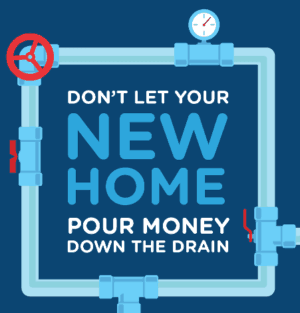Moving into a new home is an exciting yet challenging time. There’s a lot to think about and – if you’re not careful – a lot to forget about, too. One such issue is drainage, which can incur considerable expenses down the line if left unattended.
To help new-buyers begin their new adventure, we’ve assembled a guide to the most crucial drainage issues to watch out for when moving. Read on to find out how to keep your money out of the drain!
Click the image below to enlarge.
Infographic Transcript
Location Problems
In recent years, flash floods have had devastating effects on UK cities
- 2007 – Hull – £200 million of damage, affected over 1,500 businesses
- 2015 – Manchester – Tens of thousands of properties lost power after
ferocious storms
Floodplains: These low-lying areas by rivers are at especially high flood-risk, because heavy rainfall is unable to drain away. 10,000 new homes are built on them each year!
Building Problems
Poorly put together internal pipes present serious health risks. Water needs to be either above 60°C or below 20°C; anything between encourages dangerous bacteria (such as Legionella) to grow.
Rain quickly outgrows ‘a bit of water’ if your gutters are blocked by leaf mulch or moss. A little goes a long way – clean them regularly and keep them shipshape!
Offices
Working nine-to-five keeps ofce drains busy, with showers, kitchens and bathrooms all in the mix. Every business has to provide its employees with access to hot and cold water. Not doing so is illegal!
Old Properties
Lead pipes (of Cluedo fame) are toxic and not what you want in your waterways! Over time, iron pipes rust, which narrows waterways and
limits defectiveness. Occasionally, tree roots grow ingress in underground
clay pipes, causing blockages.
Industry
We recommend using interceptors and separators to prevent pollutants such as oils and fuels from contaminating waterways or soaking into the ground.
Cafe
A flourishing business’ drains are used heavily and need keeping spick and span! Oils and drains don’t mix, though all too often they do! Over time, excess builds up and can evolve horrifyingly into monstrosities known as
‘fatbergs’. We aren’t joking; neither are they!
Pipe maintenance
- Water mains
- What? These large pipes carry water around the country. They’re usually laid under roads.
- Who is responsible? The water company
- Communication pipes
- What? These pipes transport water from the water mains to each property’s boundaries.
- Who is responsible? The water company
- Supply pipes
- What? These pipes move water from the communication pipes into your building.
- Who is responsible? You! If you are renting the property rather than its owner, check the terms of your lease. It may be that your landlord is liable rather than you.
Types of Sewer Systems
Principally, your property will be served by one of two types of sewer system
- The mains sewer – These massive pipes carry wastewater away from properties. Wastewater flows through your property’s drains towards
specialised treatment plants. - Septic tanks – If your building isn’t connected to the mains sewer, it’ll likely use a septic tank instead. These are underground tanks that
decompose waste into different components.- Sludge – needs to be regularly cleaned.
- Liquid efuent – escapes into designated soakaways or waterways.
Share our infographic
Use the code below to embed our infographic on your own site:
<div id="ukdn-infographic-home"><p>Click the image below to enlarge. Source: <a href="https://ukdnwaterflow.co.uk">UKDN Waterflow</a></p><p><a href="https://i.imgur.com/Eimk1K8.png" rel="noreferrer"><img src="https://i.imgur.com/t8zSchK.png" alt="Infographic: Don't let your new home pour money down the drain"></a></p></div>


